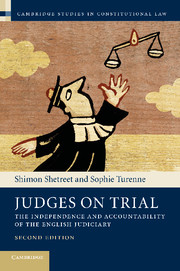Book contents
- Frontmatter
- Contents
- Foreword
- Acknowledgments
- Table of cases
- Table of legislation
- List of Abbreviations
- 1 Introduction
- 2 Constitutional steps towards judicial independence
- 3 The structure and governance of the English judiciary
- 4 Judicial appointments
- 5 Standards of conduct on the bench
- 6 Standards of conduct in extra-judicial activities
- 7 Immunity, discipline and removal of judges
- 8 Freedom of expression and public confidence in the judiciary
- 9 Conclusions
- Annex 1 Courts and tribunals structure
- Index
- References
3 - The structure and governance of the English judiciary
Published online by Cambridge University Press: 05 June 2014
- Frontmatter
- Contents
- Foreword
- Acknowledgments
- Table of cases
- Table of legislation
- List of Abbreviations
- 1 Introduction
- 2 Constitutional steps towards judicial independence
- 3 The structure and governance of the English judiciary
- 4 Judicial appointments
- 5 Standards of conduct on the bench
- 6 Standards of conduct in extra-judicial activities
- 7 Immunity, discipline and removal of judges
- 8 Freedom of expression and public confidence in the judiciary
- 9 Conclusions
- Annex 1 Courts and tribunals structure
- Index
- References
Summary
Introduction
3.1 This chapter comprises four sections. First, we set out an overview of the structure of the courts and tribunals. Second, we consider the judicial hierarchy of those courts, with some observations on tribunals. Third, we examine the recent transfer of judicial governance by civil servants to the partnership with the judiciary and Her Majesty’s Courts Service (HMCS, recently relabelled HMCTS (Her Majesty’s Courts and Tribunal Service) to reflect the inclusion of tribunals). Fourth, we discuss three particular administrative responsibilities which are now transferred to judges, namely decisions on deployment and case assignment given to senior judges and the increased emphasis on case management for all trial judges.
Laws are of little value if the legal system does not provide an efficient method for enforcing them and obtaining redress for their violation. This requires an efficient organisation of the judiciary and an efficient judicial process, characterised by consistency and constancy. In this respect, the Concordat and the Constitutional Reform Act 2005 (CRA) vest in the Lord Chief Justice some considerable responsibilities in respect of the judiciary and of the business of the courts of England and Wales. This may explain why for most judges interviewed the administration of justice was seen as one the main areas where changes had deeply affected the judiciary. The Lord Chief Justice exercises these responsibilities by delegation, thereby formalising the existing hierarchy and leadership positions within the judiciary and reflecting specific arrangements for judicial governance. These structures and practices determine the way in which judges relate to each other and achieve a sense of collective independence. The Senior President of Tribunals is at present a separate judicial office with similar, but not identical, responsibilities to the Lord Chief Justice.
- Type
- Chapter
- Information
- Judges on TrialThe Independence and Accountability of the English Judiciary, pp. 47 - 101Publisher: Cambridge University PressPrint publication year: 2013

